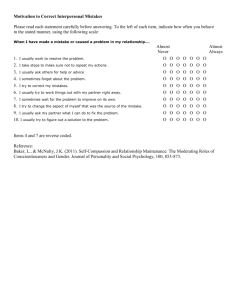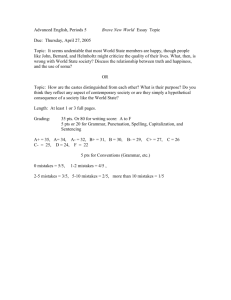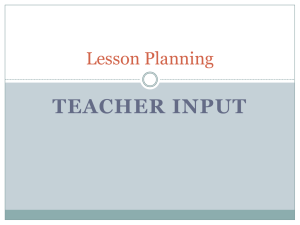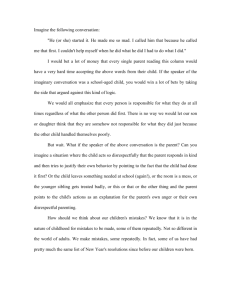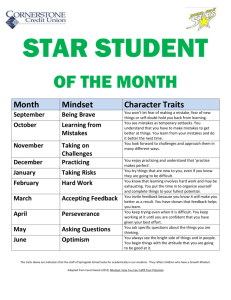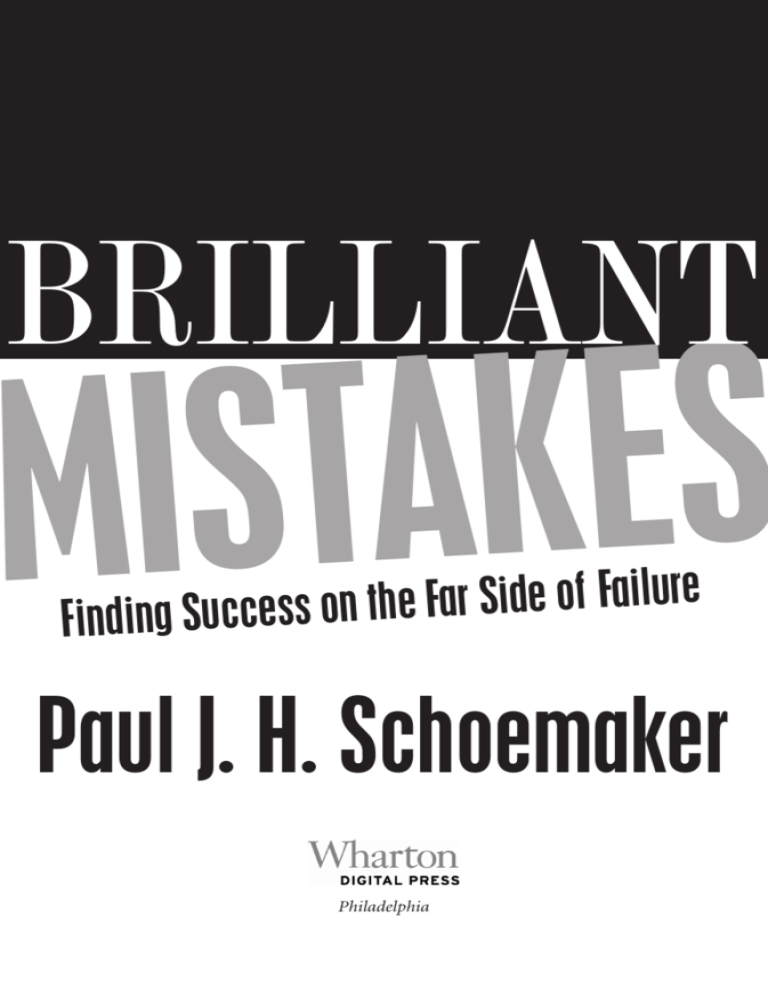
BRILLIANT
S
E
K
A
T
MIS
re
u
il
Fa
f
o
e
id
S
r
Fa
e
th
n
o
Finding Success
Paul J. H. Schoemaker
Philadelphia
© 2011 by Paul J. H. Schoemaker
Published by Wharton Digital Press
The Wharton School
University of Pennsylvania
3620 Locust Walk
2000 Steinberg Hall-Dietrich Hall
Philadelphia, PA 19104
All rights reserved. No part of this book may be reproduced,
in any form or by any means, without written permission
of the publisher. Company and product names mentioned
herein are the trademarks or registered trademarks of
their respective owners
Ebook ISBN: 978-1-61363-011-2
Paperback ISBN: 978-1-61363-012-9
Contents
Preface . . . . . . . . . . . . . . . . . . . . . . . . . . . . . . . . . . . . . . . . . . . . . . . . . . . . . . . . . . . . . . vii
Introduction: When Wrong Is Right . . . . . . . . . . . . . . . . . . . . . . . . . . . . . 1
Part One: Rethinking Mistakes
Chapter 1: Context Matters: Defining Mistakes . . . . . . . . . . . . . . . 11
Chapter 2: Not All Errors Are Equal: Brilliant Mistakes . . . . . . 27
Chapter 3: Why and How We Err: Causes and Remedies . . . . . 41
Part Two: Designing for Mistakes
Chapter 4: Faster Learning: A Practical Road Map . . . . . . . . . . . . 63
Chapter 5: Deliberate Mistakes:
Creating Portals of Discovery . . . . . . . . . . . . . . . . . . . . . . . . . . . . . . . . . 79
Chapter 6: Portfolio of Mistakes:
Hedging Conventional Wisdom . . . . . . . . . . . . . . . . . . . . . . . . . . . . . 103
Part Three: Putting It All Together
Chapter 7: The Prepared Mind: Detecting Anomalies . . . . . . . 119
Epilogue: Musing About Mistakes . . . . . . . . . . . . . . . . . . . . . . . . . . . . . 135
Appendix A: Einstein’s 23 Mistakes . . . . . . . . . . . . . . . . . . . . . . . . . . . . 147
Appendix B: Expected Utility Analysis . . . . . . . . . . . . . . . . . . . . . . . . 149
v
Appendix C: Portfolio Justifications . . . . . . . . . . . . . . . . . . . . . . . . . . . 151
Appendix D: How Your Mind Plays Tricks . . . . . . . . . . . . . . . . . . . . 154
Acknowledgments . . . . . . . . . . . . . . . . . . . . . . . . . . . . . . . . . . . . . . . . . . . . . . . . 157
Notes . . . . . . . . . . . . . . . . . . . . . . . . . . . . . . . . . . . . . . . . . . . . . . . . . . . . . . . . . . . . . . . 159
Index . . . . . . . . . . . . . . . . . . . . . . . . . . . . . . . . . . . . . . . . . . . . . . . . . . . . . . . . . . . . . . . 169
About the Author. . . . . . . . . . . . . . . . . . . . . . . . . . . . . . . . . . . . . . . . . . . . . . . . . 175
Preface
Mistakes…are the portals of discovery.
—JAMES JOYCE1
f you have ever flown in an airplane, taken an antibiotic, or
used electricity from a nuclear power plant, you have firsthand experience with the power of mistakes. Each one of those
innovations resulted from a flash or two of brilliant insight and
many, many years of wrong answers, dead ends, and missteps.2
The ill-fated flight at Kitty Hawk showed how an idea
that seems impossibly wrong can be achieved by two Wrights.
Alexander Fleming’s accidental discovery of penicillin, the
world’s first and most successful antibiotic, involved a sloppy
lab, keen perception, and an exceptionally well-prepared
mind. Scientists labored for decades to harness nuclear
power, beginning with Einstein’s landmark 1905 article in
the Annals of Physics arguing that mass (m) can be converted
into energy (E) via the formula E = mc2 (where c is the speed
of light).3 Even though Einstein’s articles were brilliantly original, they contained numerous mistakes, at least 23 according
to one careful study (see appendix A). However, many of
these errors were actually helpful, and some even necessary,
to sustain Einstein in developing his revolutionary theories
about mass, energy, gravity, time, and space.4
It would take several more decades before another brilliant scientist, Enrico Fermi, provided irrefutable empirical
evidence in support of Einstein’s famous formula. Using a
converted squash court at the University of Chicago, Fermi
I
vii
viii
Brilliant Mistakes
was able to achieve the first-ever controlled release of nuclear
energy in 1942. He later joined Oppenheimer’s Manhattan
Project in Los Alamos, where they developed the world’s first
atomic bomb, building on the earlier experiments in that
converted squash court. The atom bomb shows Einstein’s
formula that E = mc2 with a big bang and brought the Second
World War to a quick end. It also shows that mistakes can be
beneficial to discovery and may be necessary to arrive at deep
new insights. Even a genius like Einstein could not do without them.
Brilliant Mistakes examines the beneficial side of error
by considering mistakes as “portals of discovery.” Through
stories and analysis, I show that it’s possible to design for brilliant mistakes—those that accelerate learning and lead to
breakthrough innovation—and to avoid tragic ones. I also
argue that all mistakes are not created equal. Some have high
cost and offer little learning value, while others cost little and
produce deep, valuable insight. These are the brilliant
mistakes, the ones to embrace rather than avoid. This book
will teach you how to recognize, foster, and reward them in
yourself and others.
Think about the last time you tried something new,
whether it was acquiring a language, learning a new sport, or
starting a company. Did you make errors along the way? Did
those errors help or hinder your progress toward your goal?
The path from insight to discovery is seldom a straight line.
Most groundbreaking achievements in science, technology,
economics, and the arts represent long, meandering paths of
misjudgments and false turns. Indeed, our very existence as
humans relies on the error mechanism of random mutation;
we would not exist if our evolutionary process had not
included a few hiccups and false turns. But it isn’t enough
just to accept that mistakes are part of progress. We can do
better than simply rely on random error to eventually point
Preface
ix
the way. We can, and should, learn to be strategic about the
errors we allow.
Unfortunately, the systems that surround us make this a
difficult proposition. Our schools and organizations are
designed for efficiency and order. These are fine principles
but rarely encourage mistakes, either brilliant or foolish.
Students are graded on how much they know, not on the
degree to which they learn from helpful errors. Similarly,
companies strive for error elimination, hiring advisers and
relying on sophisticated management tools such as Six Sigma.5
It’s little wonder, then, that most decision-making books
follow suit, encouraging you to focus narrowly on mistake
avoidance today rather than provoking you to plan for the
stream of decisions that you will face tomorrow.
Ironically, the University of Chicago, that bulwark of
rational economic thinking propelled by Milton Friedman and
other Nobel laureates in economics, launched the first academic
center among business schools to study our less rational side.
As a faculty member at the business school’s Center for Decision Research, I spent twelve years among colleagues doing
research on subjects that seemed, to some at the time, esoteric
and off-kilter. We studied how experienced executives could
be blinded by their frames of mind or why numerous traps
and biases might cloud their judgment and choices. At first,
most esteemed economists looked askance at our studies and
findings.6 Paradoxically, it turned out to be a brilliant mistake
for the University of Chicago’s business school to encourage
a small group of intellectually diverse scholars to challenge
basic tenets underlying the rational economic model.
The field of behavioral decision theory has since gained
great momentum across multiple academic disciplines. The
principles that underlie it—such as the idea that humans are
error-prone, that consumers exhibit predictable biases, and
that markets are not always efficient—have gained wide
x
Brilliant Mistakes
attention and infiltrated popular thought. In 2002, the Nobel
Prize in Economics was awarded to Daniel Kahneman, a
psychologist who was then at Princeton University. Such lofty
recognition for research done by someone outside of
economics is quite unusual, although not unprecedented.7
Kahneman’s groundbreaking work in prospect theory as well
as heuristics and biases, research he conducted mostly with
another brilliant cognitive psychologist, the late Amos Tversky,
showed that people’s decisions are strongly influenced by
psychological factors.
The mantle of behavioral decision theory has been worn
by many others and has spawned an active research community. The Society for Judgment and Decision Making counts
over 1,000 academic members, many of who conduct
research.8 Popular books drawing on the field, with such titles
as Freakonomics, Predictably Irrational, and Nudge, fill book
shelves and e-readers.9 This new behavioral discipline is also
embraced by government leaders, including advisers in the
Obama administration who wish to explore new approaches
to health care, education, and other thorny policy issues.10
In this book, I build on the strong theoretical foundation
of decades of research in decision psychology as well as
behavioral economics and go even a step further. I offer a
practical plan for separating destructive from constructive
mistakes and for learning to make more of the brilliant kind.
By exploring how to access mistakes for their learning potential, I will encourage you to challenge cherished assumptions
and improve your future prospects. I will even, at times,
suggest that you make mistakes on purpose—all in the spirit
of challenging false beliefs and accelerating learning. I will
not simply encourage you to accept that you, like every other
person on the planet, are error-prone—I will encourage you
to embrace this quality, to milk it for all of its evolutionary
and learning potential.
Preface
xi
The stories, frameworks, and insights of this book
emphasize the following key messages:
1. It is important to embrace the learning potential of
mistakes—first, by overcoming the shame and fear
that lead us to overlook the covert messages they carry
about how we think.
2. To learn from a mistake, it’s critical to separate the
decision process—the part that you own—from the
outcomes, which are usually influenced by external
factors.
3. There is a difference between silly errors and brilliant
mistakes, and it all hinges on the relative costs and
benefits of what is at stake. Designing for, and learning from, a mistake can make it brilliant.
4. In some cases, it’s advisable to allow room for
mistakes to be made. Just as random mutations have
advanced evolution, clever, well-designed mistakes
can further human progress by opening new vistas.
For most people, the problem is not that they make too
many mistakes but too few. Ask a few elderly people you know
about their areas of greatest regret, and most will recount
errors of omission rather than commission—what they failed
to do rather than what they did. People are quick to agree that
in retrospect, one can learn much from mistakes, and that
some mistakes therefore can have great value. When I ask
experienced managers in executive programs what they have
learned from most in life, they usually say mistakes. When I
reply, “Since mistakes have been so valuable to you, why don’t
you make a few more?” they tend to look back at me with
puzzled faces. The idea of purposeful mistakes runs counter
to the zero-tolerance management approach of reducing error
whenever and wherever possible.
xii
Brilliant Mistakes
Brilliant Mistakes provides a road map for designing for
and learning from error. It helps you assess your own decisionmaking process and clear through the brush of the emotional
and cognitive reactions, like shame or the deflection of
blame, that tend to cloud your ability to learn from your own
mistakes. I provide insights about how and why you make
decisions, and I offer processes to improve your judgment
and choices. I also go further and explore a controversial
question: if a few mistakes can be good, wouldn’t a few more
be even better? To learn maximally from mistakes, we need
to commit more errors than we deem optimal as judged
within the bounds of our limited rationality. This idea may
be hard to swallow. Yet it is the quintessential insight of this
book, made practical through example, exposition, and
advice on when and how to make smart mistakes.
It’s my hope that this book will help you be a little less
perfect—and a little wiser about and tolerant of mistakes. If
you follow its guiding principles, you will gain new insight
about different types of errors we make, and you’ll learn how
to recognize situations in which mistakes could be beneficial.
Along the way, you’ll come to accept the counterintuitive
notion that we sometimes should deliberately commit errors,
as they may be our only chance to move to greater understanding. I look forward to guiding you to your own portals
of discovery, knowing that these portals will help you in
business and beyond.
Introduction
When Wrong Is Right
n a frigid New Year’s morning, an obscure music group
auditioned for an executive at one of the world’s leading
record companies. After years of modest success playing local
clubs, this band was looking for their big break. In order to
make it to this audition, they had braved a ten-hour ride
through a blinding snowstorm. Their driver had gotten lost,
but they had still arrived before the executive, who had been
toasting in the New Year the night before. This band was one
of many he would audition that year, including at least one
other audition later that same day. Band and executive were
both exhausted. The band’s equipment was dilapidated from
months on the road; the studio executive substituted his own
amplifiers. It was not an auspicious beginning.
Once in the studio, the band spent an hour taping a
dozen songs. This tape ended up in the hands of the seasoned
head of the artist and repertoire (A&R) department for Vox
Music, a prominent label. He turned it down. The style of the
band’s music, he felt, was on the way out. He was in good
company. A few weeks earlier, the general marketing manager
of Epsilon Records, another top recording company, had also
checked out this same band and come to the same conclusion. In a letter to the group, Epsilon’s general marketing
manager made the following curt assessment: “While we
O
1
2
Brilliant Mistakes
appreciate the talents of this group, we feel that we have sufficient groups of this type at the present time under contract.
It would not be advisable for us to sign any further contracts
of this nature.” Around the same time, two other recording
companies listened to the band, and the reply was the same:
a polite or impolite but emphatic no. In total, the band was
turned down by at least four respected recording companies
after getting a fair hearing at each.
“With Every Mistake We Must Surely Be Learning”
That should have been the end of the story. One card,
however, remained in play. The head of A&R for one of
Epsilon’s smallest labels was out of town during the general
manager’s deliberations. His absence seemed a small matter
at the time, since this label was—according to one Epsilon
insider—the “joker in the pack, and not just because it
released many comedy records. In terms of budget, hits, and
prestige it was the poor relation of the company’s powerful
labels.” With the exception of a label devoted to Salvation Army
Bands, it was Epsilon’s poorest performer. What could this
manager possibly add to the evaluation of an up-and-coming
rock band? More respected executives, closer to this genre of
music, had already rendered a verdict of thumbs-down.
But six months later, the band’s persistent manager
brought its audition tapes through the back door of Epsilon
and appealed to the head of this small label. This young
maverick was both passionate and ambitious. After a stint in
the navy, he had joined Epsilon as an assistant to the manager.
He sought out new and untapped bands and developed niche
markets, such as comedy records, into profitable businesses.
Five years later, at age 29, he would assume leadership of the
label, making him the youngest label chief in Epsilon’s history.
He had a prescient understanding of how new recording technologies would have an impact on the future of the music
Introduction
3
industry. Because he was forced to feed on the scraps of the
corporation’s artists, he developed close working relationships
with talent, in contrast to the typical arm’s-length relationships of most managers. He was eager to change the world.
This manager was intrigued by what he heard on the
band’s demo. He decided to invite them back for another audition. During the audition, he was more impressed by their wit
and potential than by the music they played for him, but he
decided to sign them nonetheless. All this happened just six
months after the best minds of the very same recording
company had turned the band down. There had always been
independent decision making at Epsilon labels, but this reversal
came as a bit of a surprise to Epsilon’s general manager, who
was responsible for multiple labels. After the contract was inked,
he wrote to the band with a hint of embarrassment to explain
“what may appear to you to be an anomaly in our Organization. I can assure you that the artist managers did hear the
record but I know you will appreciate that even artist managers
are human and can change their minds!” How could a comedy
album executive be signing a rock band, against the better judgment of senior colleagues who truly had their fingers on the
pulse of the industry? This was surely a mistake, right?
What’s Your View?
• Was the comedy album manager wise to sign the band
through the back door?
• Should Epsilon’s general manager have blocked signing
the band a second time?
• Was the band at fault for showing up late for the audition, without all equipment?
Was
the band smart in reapproaching Epsilon Records
•
through the back door?
4
Brilliant Mistakes
Most people read this case and decide that it was a mistake
for the label to sign the band—that is, unless they are fans of
music history and recognize the details of the story or pick up
the clue in the title to this section. Here’s a hint: it’s a quote
from their famous song “While My Guitar Gently Weeps.”
You’ve got it: this story is about the discovery of the Beatles.
The young executive was George Martin of the Parlophone
label at EMI (disguised as Epsilon Records). By ignoring
conventional wisdom and making a move most would deem
a “mistake,” Martin helped his company become a dominant
player in the recording business. As Beatlemania spread
across the globe, the Fab Four became one of the most
successful groups of all time, selling over a billion records
internationally. They sold more albums in the United States
and earned more number one albums on UK charts than any
other band. Decca, the recording company that passed on the
Beatles after the January 1962 studio audition (disguised, in this
anecdote, as Vox), is now famous for what seems the most
glaring oversight in music history. Especially ironic, in hindsight, is their declaration at the time that “groups of guitars
are on the way out.”11 Instead, they signed Brian Poole & the
Tremeloes. How many people still remember that group?
The Path to Brilliance
I’ve opened this book with the Beatles’ discovery story
because it illustrates one of the central propositions of this
book: the degree to which assumptions deeply held by the
best and brightest can be wrong and the enormous potential
benefit of seeing past them and making a brilliant mistake.
Assumptions can be wrong for numerous reasons, ranging
from changes in the world in which the assumptions were
formed to lack of humility among those at the top. In the
case of all of the Vox executives, and all but one of the Epsilon
executives, many of these factors were probably in place.
Introduction
5
That leaves us with George Martin. What did he know
that nobody else knew? In truth, we know too little about
Martin’s inner thought process to be sure. He could have
simply been foolish and lucky. As we’ll see throughout this
book, many stories of great discoveries can be interpreted as
entirely reliant on dumb luck. It’s also possible that he saw
that the world was changing and that the assumptions his
industry was built on would not continue to hold in the
future.12 To the extent that the latter is true, he’s a great example
of someone who was able to understand himself and the
world around him well enough to make the risky, highreward move of a brilliant mistake.
George Martin certainly wouldn’t have viewed his signing
the Beatles as a mistake. No self-respecting manager would
ever knowingly make a mistake. Like Martin, managers view
their role as taking calculated risks that yield, on average, a
positive payoff. But if the Beatles had indeed been a huge flop,
as many in the industry expected, we would now consider
Martin’s decision a mistake. Luckily for him, the opposite
happened. The Beatles rose to global dominance in pop
music. In retrospect, Martin is viewed as a visionary who
made a brilliant decision. But should our judgment about
whether Martin’s decision was brilliant or misguided really
hinge so much on that remarkable outcome? If someone wins
the lottery, was buying that winning ticket a good decision on
that occasion (and a bad one most other times when the
payoff was nil)? Few of us would scold a friend who won the
lottery for having been so wasteful. Instead, we congratulate
the person, with perhaps a touch of envy. But shouldn’t we,
in all fairness, base our assessment on what our friend or
someone like George Martin could reasonably have known
and predicted prior to the decision? Many theorists would
argue that this should be the standard of judgment, without
the distortions due to knowledge obtained in hindsight.
6
Brilliant Mistakes
Once we adopt this theoretically pure standard, another
issue arises. Can we ever judge fairly, in hindsight, whether a
decision was smart or dumb? To what extent can we put
ourselves in the shoes of someone else and ignore all other
information, including what happened after the decision?
Before you learned that the band was the Beatles, who did
you side with: the seasoned executives or the young manager?
The challenge in understanding mistakes is that we make
decisions looking forward and judge them in hindsight. How
do you determine what is a good mistake in light of this? And
what is the difference between taking a risk and making a
mistake? George Martin intuitively appreciated the difference
between a dumb mistake and a brilliant one. In signing the
Beatles, Martin minimized his downside risks. As he
commented later, “To say I was taking a gamble would be
stretching it, because the deal I offered them was pretty
awful.” The Beatles received one penny for each record sold.
At the time Martin made his offer, the Beatles were happy to
take any contract with a major label such as EMI.13 Although
he wrote a tightwad contract, Martin could have signed
another band that would have had a higher likelihood of
success, so he took a risk nonetheless.
This book examines why a set of popular views of
mistakes may be deeply mistaken and offers a new way of
looking at (and benefiting from) mistakes. I begin with the
view that there are four different kinds of mistakes (tragic,
serious, trivial, and brilliant), and then I turn to the practical
question of how we can err our way to success. The main
benefit of mistakes is that they speed learning. Martin’s decision changed the music industry. Even though there was
already a trend in the making, it might not have flourished
quite the way it did if gatekeepers had continued to sign the
same acts. Repeating the same formula over and over builds
expertise in a narrow field—a form of accretive learning. As
Introduction
7
physicist Niels Bohr (1885–1962) said, “An expert is a person
who has made all the mistakes that are possible in a very
narrow field.”14 Brilliant mistakes, in contrast, expand the
field and accelerate learning beyond the narrow confines of
conventional wisdom. This is expansive rather than convergent learning. Sometimes there is no way to reach a destination through incremental accumulation of knowledge, just as
you cannot cross a chasm in small steps. You need to take the
leap of brilliant mistakes. Mistakes can speed learning in areas
from advertising to hiring people to speed dating, as we shall
discuss, and you can design mistakes for maximum benefit.
Beyond individual mistakes, it’s also possible to foster
ecosystems at an organizational or even a societal level that
allow mistakes to have broad benefit. How can we optimize
our portfolios of mistakes? How can we make fewer tragic
and serious mistakes and not be distracted by trivial ones?
How can we recognize and encourage brilliant mistakes?
EMI’s Ron White, who had turned down the Beatles personally, created an organization that allowed Martin to sign the
band through the back door. This kind of slack, which is
largely absent in many companies today, fosters opportunities for creativity and innovation. White appreciated this
diversity and the willingness of managers to change their
minds about past decisions, even if it meant writing a letter
of apology to the Beatles to clarify what might appear to be
an “anomaly” in their organization. Diverse thinking and
tolerance for mistakes are both critical to innovation since
they allow for variation beyond what is normally seen. At
times, we need to design ecosystems of mistakes.
Real-life mistakes are complex and messy. Although
many autobiographies paint an incomplete and self-serving
picture of what led the author to greatness, many successful
people have honestly acknowledged the role of mistakes in
their own lives. The concluding chapter recounts how leaders
8
Brilliant Mistakes
in diverse fields have leveraged mistakes to advantage. From
Albert Einstein to Jack Welch, we shall see that mistakes played
a crucial role in the success of many remarkable people. Using
their stories and other famous successes, we shall offer a practical and very personal view of the principles discussed
throughout the book. The key message is that mistakes are
essential to success and that most people don’t look at mistakes
in the right way. Few of us use mistakes as fully as we can. As
Eleanor Roosevelt said, “Learn from the mistakes of others.
You can’t live long enough to make them all yourself.”
The first part of the book, “Rethinking Mistakes,” examines the meaning of mistakes and their often hidden value.
It argues that we need to change our thinking about mistakes
in rather fundamental ways to reap their full benefits. The
second part, “Designing for Mistakes,” examines strategies
for making mistakes on purpose to increase the odds of brilliance. Creative industries, from movie production to basic
science, are better at tolerating mavericks. Sometimes crazy
ideas and unlikely performers become phenomenal successes,
as demonstrated by programs such as American Idol (or the
surprising discovery of Susan Boyle in the British version)
that cast a very wide net to turn up some unlikely successes.
Even so, as shown by the initial refusal to sign the Beatles,
established players often suffer from blind spots and hubris
that prevent them from seeing new opportunities. Many
industries and professions don’t appreciate the full power of
mistakes. Unwittingly, they pursue narrow strategies shrouded
in tunnel vision.
This book isn’t about luck, or coincidences, or gut feel.
It’s about deliberate, process-driven, intelligent mistakes:
presumed errors that challenge the status quo and lead to
immeasurably advantageous outcomes. But before we get
there—before we play out a strategy for making smart
mistakes—we need to establish what mistakes are and why
they happen.
Thank you for downloading your complimentary preview of
Brilliant Mistakes:
Finding Success on the Far Side of Failure
by Paul J. H. Schoemaker, PhD
To purchase the complete book from a retailer of your choice,
please visit the Wharton Digital Press website:
http://wdp.wharton.upenn.edu/books/brilliant-mistakes/

